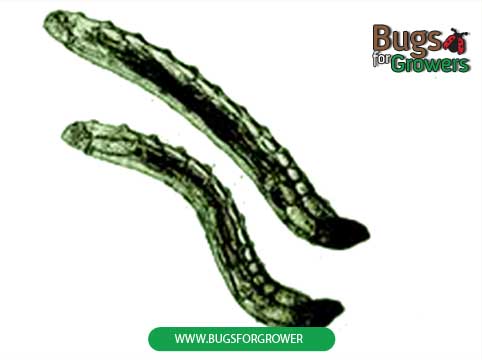The fungus gnat
Fungus gnats (Bradysia spp) are serious pests of many household plants and ornamentals grown in greenhouses and nurseries. These ornamentals include African violets, carnations, chrysanthemums, cyclamen, lilies, geraniums, impatiens and poinsettias.
Adults of fungus gnats are tiny brown or black winged insects that are always roaming in greenhouses or even in houses. Adult gnats are a nuisance to people and are known to disseminate spores of disease causing fungal pathogens from plant to plant when they migrate in through the house or greenhouse.
Fungus gnat maggots are colorless, translucent and always live in the soil. Only maggots of fungus gnats can cause direct damage to plant roots and stems by chewing/stripping and tunneling through them. While feeding on the plant roots, maggotscan also transmit disease causing fungal pathogens including Fusarium, Phoma, Pythium and Verticillium. Severely damaged plants appear unhealthy, discolored and eventually dry out.

Overlapping generations of fungus gnats in the greenhouse makes it difficult to reduce their populations to below their damaging threshold level. Relying on chemical insecticides to manage fungus gnats in greenhouses is not a safe option because they can be detrimental to both the environment and human health. Therefore, environmentally safer and effective alternatives are required for the management of fungus gnats in greenhouses.
The predatory mite
The predatory mite Stratiolaelaps scimitus previously known as Hypoaspis miles has been widely used as an effective biological control agent to control soil-dwelling stages of dark-winged fungus gnats. Predatory mites are good for controlling fungus gnats because they are adapted to survive and reproduce quickly in the same potting media/mix and the environment where fungus gnat maggots thrive best. This predatory mite generally feeds on the soil-dwelling stages of fungus gnats. Adults of Stratiolaelaps scimitus are clear brown to tan colored tiny mites that are about 0.8- 1.0 mm in size. Females of Stratiolaelaps scimitus generally lay oval shaped eggs in the soil or potting mix. These eggs hatch into tiny brown to black colored maggots. The newly hatched maggots then develop through two successive developmental stages known as protonymphal and deutonymphal stages. Both these immature nymphal stages resemble to their parents and they are known to feed on the eggs and maggots of fungus gnats that are present in the soil. The optimum temperature required for the reproduction and development of this predatory mite is between 15-25°C (59-77°F). At this temperature range these mites generally complete their egg-to-egg life cycle within 13-15 days. This means these mites will recycle themselves in the potting mix and continue feeding on fungus gnats.
For more information on the rate and timing of application of Stratiolaelaps scimitus against fungus gnats visit www.bugsforgrowers.com.
